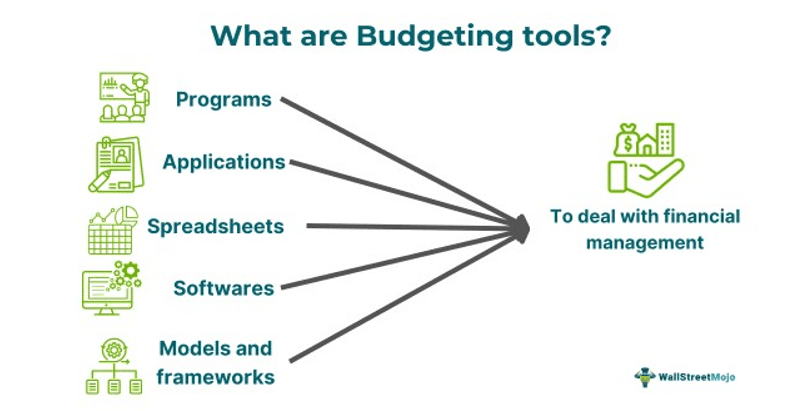Table of Contents
What Are Budgeting Tools?
Budgeting tools are anything and everything that an individual, enterprise or organization uses to streamline their finance and money management. Budgeting is a vast process requiring multiple procedures to make accurate management decisions. It comprises cash flow regulation, spending, monitoring and optimal pricing.

Budgeting tools help manage the cash and funds the company has, including the funds that will come soon. Through proper use of such tools, risk management can be implemented, and future costs and expenses can be predicted, which ultimately helps firms make sound business decisions and make optimal use of resources.
Key Takeaways
- Budgeting tools are offline and online mechanisms and programs used for total financial analysis and management.
- The tools differ for an individual and organizations as they differ in size, value, implementation, need, and objectives.
- All such top budgeting tools help in financial interpretation, save time and effort, improve efficiency and reduce the degree of error with increased profitability.
- However, budgeting tools can be complex, expensive and, most importantly, increase dependency, but they are still one of the most crucial parts of money management.
How Do Budgeting Tools Work?
Budgeting tools are used by individuals and organizations to regulate and manage their financial management. It is not a single process but a continuous process that plays a crucial role in every single aspect related to money and expenses. Budgeting tools help identify critical areas, debt issues, and over expenditures, analyze financial data and segregate essential and non-essential spending categories for both savings and investments.
Online budgeting tools are different for an individual and an organization. For the former, it can be a mobile application that tracks a person’s daily expenses to offer insights. In contrast, the latter takes a deep dive into the company books and financial statements and offers a detailed report on expenses, debt, risks, cash flow, pricing, logistics, inventory, new projects, profit, loss and cost control.
Budgeting tools are designed in such a way that they can procure every detail needed by firms; now and then, new updates and features are introduced with budgeting tools to make the whole process of financial analysis and management swift and powerful. Without the use of modern budgeting tools, the whole analysis and evaluation of cash flow and funds will take days, even weeks, with a higher degree of error and inaccuracy.
How To Choose?
Things to consider while selecting budgeting tools are -
- The most important factor is budgeting needs. It depends on whether it is an individual’s budget or a multinational corporation’s vast financial framework.
- The size of the enterprise plays a crucial role in determining the right budgeting tool; if the company is small, management should try to use free and online tools without paying.
- Every enterprise has its form of financial methodology and approach; the budgeting tool must align with it.
- Even budgeting tools cost money. Therefore, a set budget and its value must be considered while introducing budgeting tools in the company.
- Tech support and skills to manage and interpret budgeting tools with data accumulation, insights and assessment of information.
Examples
Below are two examples of budgeting tools -
Example #1
The best budgeting tools are simple and easy to use. Common examples are everywhere. A salaried person using an Excel spreadsheet to record and analyze his expenses and savings, tracking down bills and other spending using its formula, tables and structures makes the spreadsheet a budgeting tool. At the same time, a company buys finance management software for its accounts department to make sure each cash flow is recorded correctly.
Traditional good budgeting tools are primarily manual work; it can be a diary or paperwork, long manual reports and documents with receipts and invoices. At the same time, with innovation at its peak, budgeting tools can be downloaded and installed as a mobile application on a personal smartphone or tablet.
Example #2
In 2023, Intuit announced that it was shutting down Mint, a popular personal finance management website and mobile app for the US and Canada. It disappointed millions of its fans. It is an iconic budgeting tool but, most importantly, caters to the different needs of the users.
Even though Mint’s budgeting tools were popular, the company felt shy about asking customers to pay to use them. In fact, an FT partner concluded that most people have not been willing to pay for budgeting tools on a standalone basis. Its replacement is Monarch Money, which is currently recruiting former Mint users with a 50% discount on its normal fees. Commonly, most users are looking towards innovation with features like customization, AI and access to advisors.
Advantages & Disadvantages
The advantages of budgeting tools are -
- It streamlines the process and saves a lot of time, effort and control costs.
- The degree of error is reduced drastically by implementing the right budgeting tools with improved efficiency.
- Companies can plan their funding and properly allocate expenses.
- It increases profitability, and future expenses can be predicted.
- Budgeting tools offer a proper compilation of financial data with valuable insights.
- The disadvantages of budgeting tools are -
- Many of these online tools and software are expensive.
- Traditional budgeting tools may require more time, whereas modern budgeting tools can be complex to understand.
- With time, employees, staff and the whole organization depend on these budgeting tools.
- Some tools, programs and software require special operating skills, which the whole staff may not possess.

